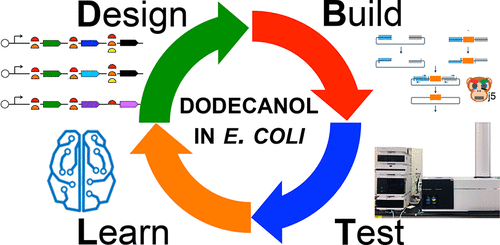当前位置:
X-MOL 学术
›
ACS Synth. Biol.
›
论文详情
Our official English website, www.x-mol.net, welcomes your
feedback! (Note: you will need to create a separate account there.)
Lessons from Two Design-Build-Test-Learn Cycles of Dodecanol Production in Escherichia coli Aided by Machine Learning.
ACS Synthetic Biology ( IF 3.7 ) Pub Date : 2019-05-24 , DOI: 10.1021/acssynbio.9b00020 Paul Opgenorth 1, 2 , Zak Costello 1, 2, 3 , Takuya Okada 4 , Garima Goyal 1, 2, 3 , Yan Chen 1, 2, 3 , Jennifer Gin 1, 2, 3 , Veronica Benites 1, 2, 3 , Markus de Raad 5, 6 , Trent R Northen 1, 5, 6 , Kai Deng 7 , Samuel Deutsch 6 , Edward E K Baidoo 1, 2, 3 , Christopher J Petzold 1, 2, 3 , Nathan J Hillson 1, 2, 3, 6 , Hector Garcia Martin 1, 2, 3, 8 , Harry R Beller 1, 2
ACS Synthetic Biology ( IF 3.7 ) Pub Date : 2019-05-24 , DOI: 10.1021/acssynbio.9b00020 Paul Opgenorth 1, 2 , Zak Costello 1, 2, 3 , Takuya Okada 4 , Garima Goyal 1, 2, 3 , Yan Chen 1, 2, 3 , Jennifer Gin 1, 2, 3 , Veronica Benites 1, 2, 3 , Markus de Raad 5, 6 , Trent R Northen 1, 5, 6 , Kai Deng 7 , Samuel Deutsch 6 , Edward E K Baidoo 1, 2, 3 , Christopher J Petzold 1, 2, 3 , Nathan J Hillson 1, 2, 3, 6 , Hector Garcia Martin 1, 2, 3, 8 , Harry R Beller 1, 2
Affiliation

|
The Design-Build-Test-Learn (DBTL) cycle, facilitated by exponentially improving capabilities in synthetic biology, is an increasingly adopted metabolic engineering framework that represents a more systematic and efficient approach to strain development than historical efforts in biofuels and biobased products. Here, we report on implementation of two DBTL cycles to optimize 1-dodecanol production from glucose using 60 engineered Escherichia coli MG1655 strains. The first DBTL cycle employed a simple strategy to learn efficiently from a relatively small number of strains (36), wherein only the choice of ribosome-binding sites and an acyl-ACP/acyl-CoA reductase were modulated in a single pathway operon including genes encoding a thioesterase (UcFatB1), an acyl-ACP/acyl-CoA reductase (Maqu_2507, Maqu_2220, or Acr1), and an acyl-CoA synthetase (FadD). Measured variables included concentrations of dodecanol and all proteins in the engineered pathway. We used the data produced in the first DBTL cycle to train several machine-learning algorithms and to suggest protein profiles for the second DBTL cycle that would increase production. These strategies resulted in a 21% increase in dodecanol titer in Cycle 2 (up to 0.83 g/L, which is more than 6-fold greater than previously reported batch values for minimal medium). Beyond specific lessons learned about optimizing dodecanol titer in E. coli, this study had findings of broader relevance across synthetic biology applications, such as the importance of sequencing checks on plasmids in production strains as well as in cloning strains, and the critical need for more accurate protein expression predictive tools.
中文翻译:

机器学习辅助在大肠杆菌中十二烷醇生产的两个设计-构建-测试-学习循环中获得的教训。
设计-建造-测试-学习(DBTL)周期通过合成生物学功能的指数提高而得到促进,它是一种越来越被采用的代谢工程框架,它代表了比以往生物燃料和生物基产品更大的系统化,高效的菌株开发方法。在这里,我们报告了两个DBTL周期的实施情况,以使用60个工程大肠杆菌MG1655菌株优化葡萄糖的1-十二烷醇生产。第一个DBTL周期采用一种简单的策略从相对较少的菌株中高效学习(36),其中只有核糖体结合位点和酰基-ACP /酰基-CoA还原酶的选择在包括基因在内的单一途径操纵子中被调节编码硫酯酶(UcFatB1),酰基ACP /酰基辅酶A还原酶(Maqu_2507,Maqu_2220或Acr1)和酰基辅酶A合成酶(FadD)。测得的变量包括工程途径中十二烷醇和所有蛋白质的浓度。我们使用在第一个DBTL循环中产生的数据来训练几种机器学习算法,并建议第二个DBTL循环的蛋白质概况,这将增加产量。这些策略使第2周期的十二烷醇滴度增加了21%(最高0.83 g / L,比以前报道的基本培养基的批处理值高出6倍以上)。除了在大肠杆菌中优化十二烷醇滴度方面的特定经验教训之外,这项研究还发现了在合成生物学应用中的广泛相关性,例如在生产菌株和克隆菌株中对质粒进行测序检查的重要性,以及对更多菌株的迫切需求。准确的蛋白质表达预测工具。
更新日期:2019-05-09
中文翻译:

机器学习辅助在大肠杆菌中十二烷醇生产的两个设计-构建-测试-学习循环中获得的教训。
设计-建造-测试-学习(DBTL)周期通过合成生物学功能的指数提高而得到促进,它是一种越来越被采用的代谢工程框架,它代表了比以往生物燃料和生物基产品更大的系统化,高效的菌株开发方法。在这里,我们报告了两个DBTL周期的实施情况,以使用60个工程大肠杆菌MG1655菌株优化葡萄糖的1-十二烷醇生产。第一个DBTL周期采用一种简单的策略从相对较少的菌株中高效学习(36),其中只有核糖体结合位点和酰基-ACP /酰基-CoA还原酶的选择在包括基因在内的单一途径操纵子中被调节编码硫酯酶(UcFatB1),酰基ACP /酰基辅酶A还原酶(Maqu_2507,Maqu_2220或Acr1)和酰基辅酶A合成酶(FadD)。测得的变量包括工程途径中十二烷醇和所有蛋白质的浓度。我们使用在第一个DBTL循环中产生的数据来训练几种机器学习算法,并建议第二个DBTL循环的蛋白质概况,这将增加产量。这些策略使第2周期的十二烷醇滴度增加了21%(最高0.83 g / L,比以前报道的基本培养基的批处理值高出6倍以上)。除了在大肠杆菌中优化十二烷醇滴度方面的特定经验教训之外,这项研究还发现了在合成生物学应用中的广泛相关性,例如在生产菌株和克隆菌株中对质粒进行测序检查的重要性,以及对更多菌株的迫切需求。准确的蛋白质表达预测工具。

































 京公网安备 11010802027423号
京公网安备 11010802027423号